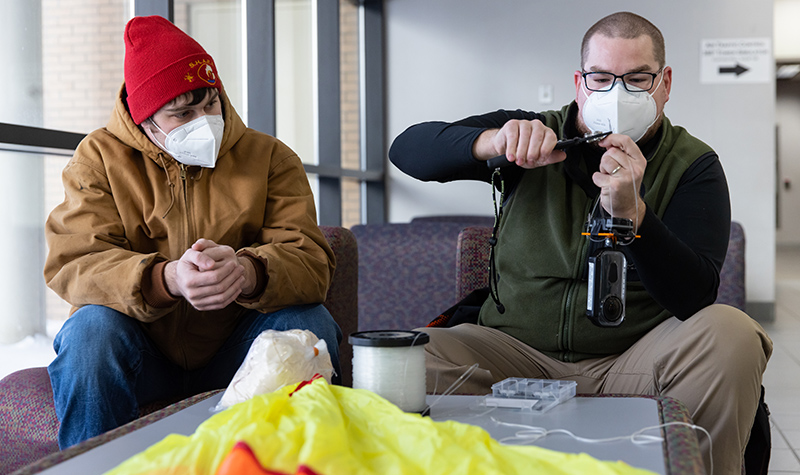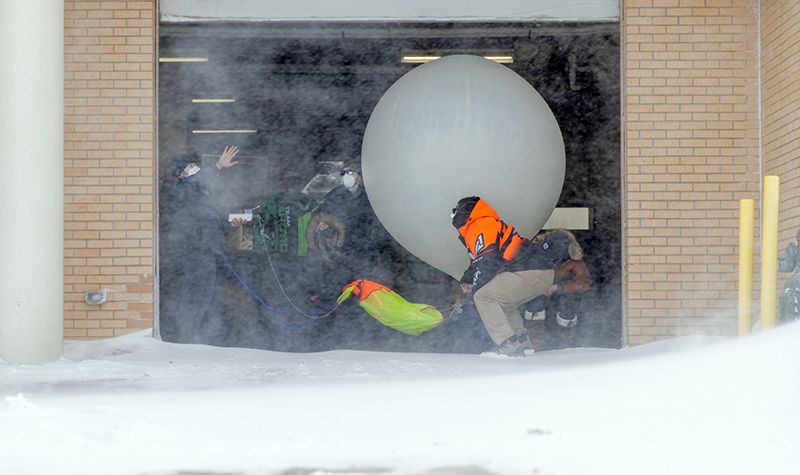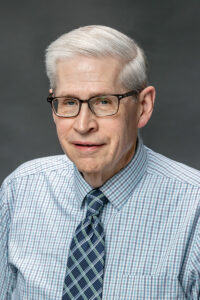Research team’s wish: Let it snow … and snow … and snow
UND’s winter-weather scientists thrive in blizzards’ snow, wind and cold

Many residents of the Red River Valley in eastern North Dakota probably agree that experiencing blizzard after blizzard during the winter of 2021-22 has pegged their BS meters — Blowing Snow, that is — completely off the dial.
However, if your job is to study Blowing Snow, then these past winter months begin to look more like a winter wonderland and less like prolonged torture.
Yes, Virginia, there are people who actually enjoy a good blizzard with zero visibility, blowing snow and wind chills far below zero.

It’s as if Aaron Kennedy, associate professor in the University of North Dakota Department of Atmospheric Sciences, and his students can’t get enough bad weather. In the summer, they chase severe thunderstorms and tornadoes. In the winter, their interest turns to blizzards.
When you see Kennedy and his students outside Clifford Hall in a raging blizzard launching a weather balloon while everyone else is more than happy to stay warm and cozy inside, you know it can’t get much worse.
But don’t feel sorry for them. They like it.
Winter work ethic
“When UND closes, we go to work,” Kennedy explained, before adding with a laugh, “We need jackets with that motto.”
Talia Kurtz, a first-year master’s student from Reno, Nevada, grew up experiencing snow and cold during occasional drives with her grandparents over the Sierra Nevada mountains. She’s accomplished her goal of surviving a blizzard and has made a point of walking in all eight of the named blizzards Grand Forks has experienced this winter.
“Before coming to UND, I’d never launched a weather balloon,” Kurtz confessed. “The first blizzard we launched a balloon in, I showed up looking like a pink abominable snowman. It’s been really fun.”
However, the research Kennedy and his group conduct has a serious purpose. Their objective is to make the models the National Weather Service (NWS) and other meteorologists use to forecast severe winter weather more accurate and more reliable. In particular, their focus is on the blowing snow events that are not only dangerous, but also difficult to predict.

“We’re demonstrating new observation technologies that could potentially be incorporated into the forecasting workspace,” Kennedy said. “We have cameras that take tons of pictures of snowflakes and instruments already deployed at airports around the region that could provide data currently going unused.
“We want to show that these instruments are now at a price point that they could conceivably be deployed to provide information on blowing snow and what’s falling from the sky to help monitor conditions in real time,” he added.
This winter, most of the blizzards experienced in the Red River Valley have been ground blizzards created by blowing snow. They usually last less than a day and produce little snowfall. But because they occur close to the earth’s surface where they’re difficult to observe with radar, they’re not well understood, which makes accurately forecasting them a challenge.
“When I told my family my research was in blowing snow, my sister said, ‘How difficult can it be? Wind goes whoosh. Snow goes whoosh,’” said Alec Sczepanski, a first year Ph.D. student from Lancaster, N.Y.
“But it’s a lot more complex than that,” he noted. “There are many variables that go into predicting and trying to figure out where and when it’s going to happen.”
Looking for validation
That’s where the work of Aaron Scott, an atmospheric science Ph.D. student from Ardmore, Oklahoma, enters the picture. He’s working to validate computer models of blowing snow events in North Dakota.
“I’m looking at how we can get an operational model for North Dakota to forecast ground blizzards, which are lofting snow that’s not precipitating from a cloud,” he explained. “We’re looking to incorporate this with the National Weather Service and possibly other operational meteorologists who are interested.”
Kennedy’s research group is involved in two separate winter weather research projects. One is a $457,000, two-year project funded the National Oceanic and Atmospheric Administration (NOAA) in collaboration with Norman Wood, a scientist at the University of Wisconsin in Madison.
UND’s space studies and biology departments are providing facilities for weather instruments located at the Oakville Prairie Field Station and Observatory near Emerado. The North Dakota Agricultural Weather Network (NDAWN) at North Dakota State University and NWS offices in Grand Forks and Bismarck are also involved.
Currently, there are instruments at airports throughout the region called ceilometers, used to give pilots information on cloud ceilings by projecting a laser beam straight up. According to Kennedy, these instruments could also be used to provide real-time data on blowing snow or precipitation to aid in making more accurate forecasts.
“We’ll be able to develop algorithms that can detect blowing snow,” Kennedy said. “The idea is that we’ll pass this information on to NOAA – and if they think it’s useful – then perhaps we can find a way to make this happen with the instruments already out there.”

The second research project being conducted this winter received $14,000 in funding from the North Dakota Space Grant in collaboration with Stephen Palm, a research meteorologist at the NASA Goddard Space Flight Center.
The weather balloons launched from the UND campus during blizzard conditions provide data to NASA’s ICESat-2 satellite (Ice, Cloud and land Evaluation Satellite-2) as it passes overhead. Because the balloon launches are timed with the satellite overflights, they can happen late at night or early in the morning.
“The most active student involvement has been in the balloon project,” Kennedy said. “We’ve had at least two dozen different students help out with balloon launches. One of the best parts is that it’s a very hands-on activity. Putting a balloon in the atmosphere is a time-honored tradition for meteorologists.”
Research in action
Kennedy is hopeful that the results of both projects will translate into the operational world of NWS offices in North Dakota, helping to make accurate forecasts that keep the public safe.
“Since we live more in the research world, we have an idea of how this information might be incorporated into the forecast environment,” Kennedy said. “NOAA and the National Weather Service people are really the boots on the ground. They can tell us what information they actually need.”
In the meantime, although the Red River Valley has experienced more spring-like temperatures recently and there’s been a lull in blizzard activity, Kennedy pointed out more winter weather could lie ahead. But that’s not considered a negative for UND’s winter weather researchers who have a wealth of data to analyze for the foreseeable future.

“A scientist who reviewed our two-year project proposal wondered what would happen if we had a mild winter without any blizzard events,” Kennedy related. “We could probably have no more events for the rest of our project and be fine because this has been such a gold mine of a winter. It was like diamonds, gold and rubies all rolled into one.”
The winter “fun” is nearing an end, but there’s still more work to be done.
“What we want to do is refine some of our measurements and instruments for the following years to demonstrate that we can produce data in real time that the National Weather Service can use and benefit from,” Kennedy said.
“We’re not going to rest on the laurels of the amazing data set,” he added. “We’ll keep pushing it while looking forward to next winter.”



